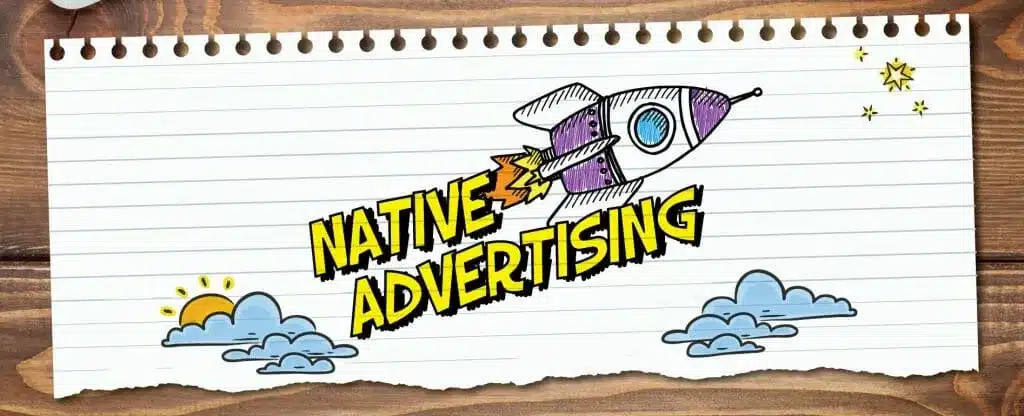Instead, it matches the style and type of content that consumers naturally see from a company.
Since native advertising is difficult to identify, it’s also difficult to explain and sell.
Still, this relatively new ad format is now leading the digital advertising industry as a powerful and creative way to win customers.
According to WordStream, 41% of brands are using native advertising today and 90% of publishers have or plan to implement it on their sites.
To help you gain a better understanding of native advertising, I’ve broken down the five Ws and one H in this complete guide. Use it to learn about native advertising, how to sell it, and how to launch it for your own business.
Vendasta offers white-label Native Advertising services for digital agencies. See a demo today.
Table of Contents
What is Native Advertising?
Examples of Native Advertising
Who is Native Advertising For?
How Native Advertising Works
Why Native Advertising?
The Challenges of Native Advertising
The Strengths of Native Advertising
The Opportunities in Native Advertising
When to Use Native Advertising
How to Start with Native Advertising
The Vendasta Equation for Agencies
Conclusion
What is Native Advertising?
Native advertising is a form of digital advertising that matches the editorial style of content on a website or publication. Unlike regular digital ads, native advertising blurs the lines between content and advertising while also disclosing its nature as an ad.
Native advertising is a play on traditional display advertising such as banners and pop-ups in which advertisers showcase their ads alongside content that’s being published on a site. Advertisers contribute either a “sponsored”, a “promoted”, or a “branded” piece of content that generally still creates value for the reader, while also subtly alluding-to or referencing the brand that is paying to have it shown. This allows companies to advertise for themselves in a way that truly creates value for the consumer, while mitigating the frustrations that are often associated with pop-ups and banners.
Here’s a short video to help explain exactly what I’m talking about when it comes to digital native advertising.
Examples of Native Advertising
Depending on the platform it’s appearing on, native advertising can look and display differently. Let’s cover a couple common examples you may see (or provide) on a daily basis.
Native Advertising Examples on Facebook
Facebook is one of the most popular websites in the world, so it makes sense that native advertising is a popular appearance on the platform.
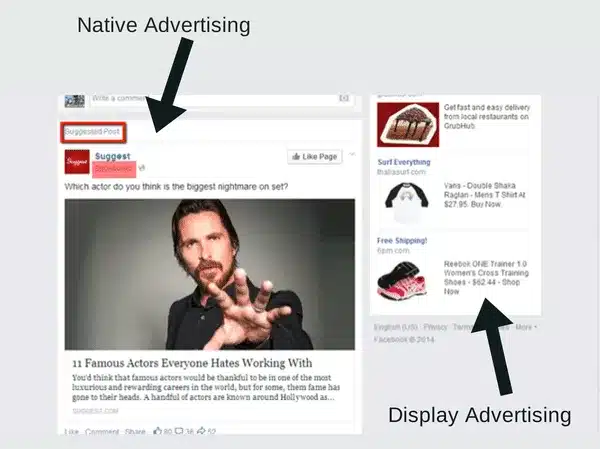
Native Advertising Examples on a News Website
As mentioned in my walkthrough, news provider sites are often the best place to find native ads that offer the greatest value to consumers.
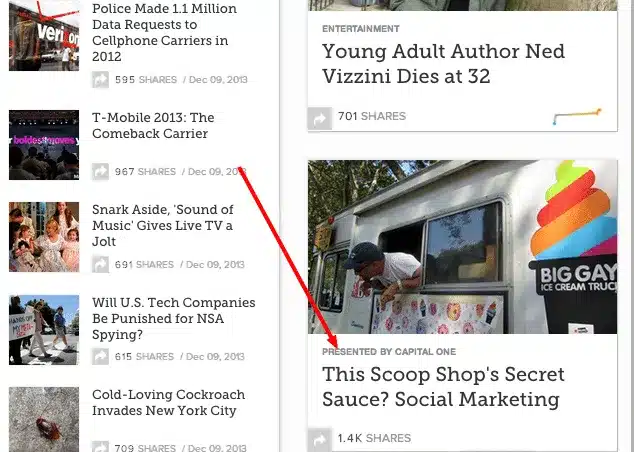
Due to the more subtle nature of native ads, they are generally classified as a top-of-funnel activity, meant to produce awareness, and potentially stir up interest.
Who is Native Advertising For?
There are four primary pools of interest surrounding native advertising:
- Publishers. Publishers are interested because they will be showcasing these advertisements, whether in digital or print format. Native ads also equate a growing source of ad revenue when many forms of display ads don’t seem to be quite as effective as they previously have been.
- Businesses. Both small and large businesses are increasingly taking interest in using this newer form of advertising because consumers are beginning to associate display ads and pop-ups with “spam”. These companies can belong to any industry or vertical—an example being Capital One in the picture above.
- Marketing Agencies. Digital service agencies are interested because this native advertising trend presents a new opportunity for them to provide the companies they serve with even greater value and variety in their offering. The role would be to write and strategize for the content, and arrange publishing for the companies that they serve.
- Consumers. Everyday consumers and business customers are the last natural component in the who equation. They value native advertising because (when used properly) it is a means of delivering value to them while also producing awareness for the brand utilizing it. It is more responsible marketing if you will, none of that black-hat stuff.
Are you good and confused? I was too, but thankfully graphics can almost always save the day for the more visual of us learners.
How Native Advertising Works
So we know what a native ad looks like, we know who the stakeholders are, but it would be even better if we had an equation for how all of these stakeholders interact, wouldn’t it? Here’s what we put together just for you:
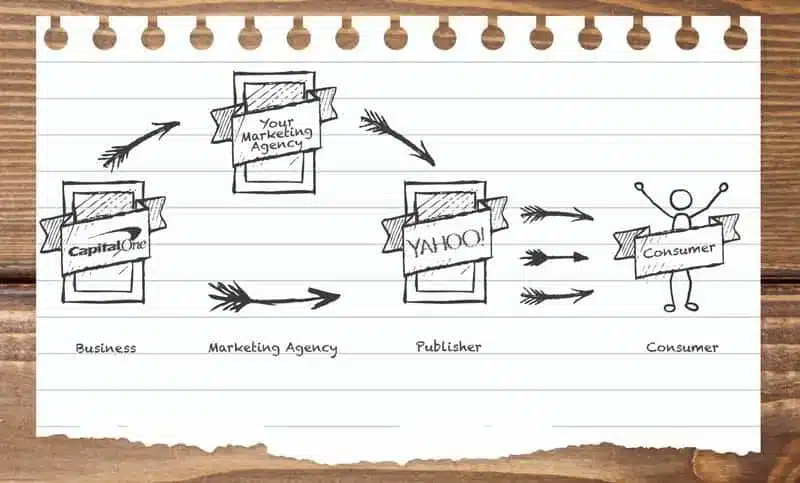
You likely noticed that there are two different equations within this graphic. The difference in these two equations is generally determined by whether or not the business in question (Capital One in this example) has an in-house marketing department, or if they outsource their marketing to another agency.
If we’re being honest, our friends at Capital One likely have their own marketing agency, so they wouldn’t need a marketing agency’s help. However, the average local business is likely lacking the means and the resources to fulfill and negotiate their own native ad work, so for them, the marketing agency route is going to be the answer.
Why Native Advertising?
Because native advertising works.
The reality is that digital is mandatory today, and sometimes it simply takes a change of pace to add some flare to a tired marketing effort. Whether you’re on the publishing side, the business side, or the advertising side of the equation, you can create a balance between the traditional lines of display advertising and curating high quality, engaging content through native advertising.
More traditional native advertising is a less-explored space than display advertising, but with consumers tiring of the “spam” and “brainwashing” of many display advertising campaigns, native is gathering momentum—fast.
I believe that more and more people are getting sick of the ads, and they are trying to find ways to incorporate advertising in an engaging fashion—and native ads seem to be the perfect balance between advertising and valuable, engaging content.
But much like native ads, we aren’t here to deceive you, so here are some of the challenges surrounding the industry:
The Challenges of Native Advertising
Native advertising is a newer addition to the advertising stack, so publishers and advertisers alike are still feeling out this unfamiliar territory. And, as you may expect, this means that there are going to be some blind spots and growing pains.
- Poor Client Understanding
In a global survey from late 2017, the Native Advertising Institute classified the primary threats to the service in the chart below. Coming in number one on the chart is a lack of client understanding, largely due to the camouflaged nature of native ads. The good news? This is a decrease of 11% from the 55% recorded in the previous year (2016).
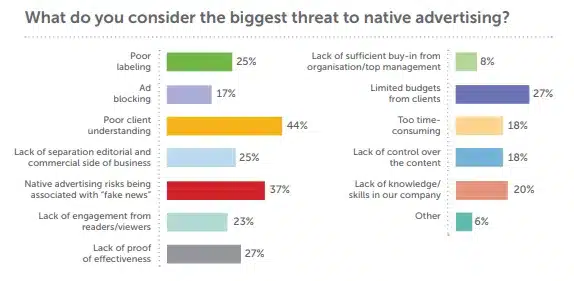
Source: Native Advertising Institute
The solution:
Easy. Tell everyone you’ve ever met to come read this blog and watch my little lesson on YouTube.
That would certainly help, but on a more serious note, it has to start with the marketing agencies. When these agencies are discussing advertising techniques with clients, they must be sure to be entirely transparent, and make the differentiation between different ads (display, paid search, native, etc.) entirely clear. The press could also help by better informing viewers of the different types of content they are seeing, but that seems like a long-shot to me…
- Diluting Brand
The second largest threat on the above chart is the risk of businesses and brands being associated with “fake news.” This is a huge concern to all who are associated with native advertising. This concern is largely founded on the basis that “fake news” has been spread through native advertising already (ex. Activities aimed to influence the most recent American presidential election).
Native advertising can also run the risk of having inconsistent voice, style, and fit with other publications when written by external writers. This is why it’s key to label this content properly and ensure quality so that consumers do not feel that they are being deceived, or fed “fake news”.
The solution:
Much like other external facing content, building a detailed brand voice and style guide for advertising efforts would allow businesses and brands to better maintain a consistent style and quality level across all channels.
In terms of combating the threats of “fake news” association, brands simply have to maintain authenticity and be genuine in all that they do. For native ads, that means producing valuable and real content that is directly relevant to the brand sponsoring it. It’s as simple as that.
For example, if you are a toothpaste manufacturer, don’t have an ad produced about how not brushing your teeth for 48 hours triples your risk of acquiring certain strains of mouth cancer—that would be a bad move.
- Publishers Failing to Label Native Ads
According to last year’s Native Advertising Trends in New Media Study, 7% of the news media publishers didn’t put any label on native ads; this year the percentage has increased to 11%. This suggests that 11% of publishers are actively deceiving their viewers by blurring the lines between editorial and ad. This is very concerning.
If publishers begin to properly label their native content, it can help prevent the same consumer alienation that has happened with many varieties of display ads.
The solution: Proper Labeling
If you are a publisher, native ads must always, always, always be accompanied by a “sponsored”, “promoted”, “advertisement”, or “presented by” declaration. If they are not labelled accordingly, this is an act of deceiving consumers.
If you are a consumer, simply make yourself aware of these different declarations so that you can better identify branded content from organically produced content.
If you want to learn more about the challenges that agencies and media companies face, and how to best remedy them, continue reading here.
The Strengths of Native Advertising
These are exciting times. Now that we have addressed some of the concerns—let’s find out why this is a strong industry already.
These strengths should also outline some opportunities for you as a business or agency to take advantage of to excel with native advertising.
- Telling Real Stories
For publishers surveyed in 2016 and 2017, one of the greatest challenges surrounding native advertising was convincing advertisers to tell real stories. Likely the result of advertisers having a somewhat difficult time transitioning to this unconventional style of advertising. The good news is that this category has declined 8% since 2016, meaning that advertisers are getting the feel for things.
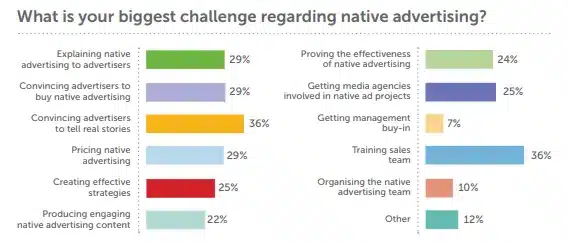

Source: Native Advertising Institute
- Cross-Platform Stories
When building a brand, it is very important to maintain a consistent story across all of the platforms that you are marketing and advertising, and the more platforms—the more exposure there is for a brand or a business. This activity is known as telling cross-platform stories.
Native advertising might be one of the most effective ways to truly leverage a brands ability to tell a story due to the story-like nature of these ads. For example, it can be quite hard to tell a story in a 2 sentence Facebook post, but when you have an entire article, it makes it much easier to bring a branded story to life.
- Native Advertising is (more) Effective
According to some studies, click-through rates on native ads have been shown to reach nearly 4 times those of display ads.
Another great thing is that native ads bypass ad blockers effectively.
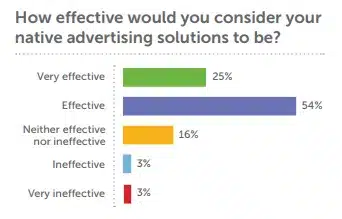

Source: Native Advertising Institute
This may indicate that not only is native advertising a great complementary solution to digital advertising, but it may be able to replace current display advertising efforts to test for efficiency and improved advertising results.
- Revenue Growth
According to the same study, titled Native Advertising Trends in News Media, native advertising is expected to generate 32% of the overall advertising revenues for publishers by 2020.
In addition to this, 51% of the publishers surveyed are already offering native advertising services. These are very promising numbers, and make right now a very opportune time to begin pursuing native ads.
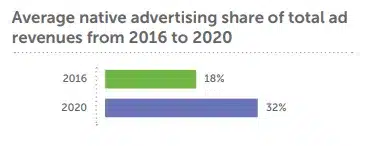

Source: Native Advertising Institute
The Opportunities in Native Advertising
Now that we’ve addressed the strength and weaknesses of native advertising, let’s discuss the opportunities that exist for all parties to take advantage of this new advertising trend.
How can you, your clients, and your business most benefit from native advertising?
- Leverage the Video Wave
Viewers are increasingly looking to video content to gather information, where they previously relied on written media. According to Cisco Visual Networking Index, 82% of all consumer Internet traffic will be video by 2020. This trend applies to native advertising as well.
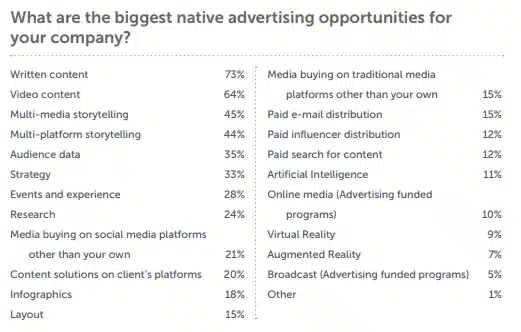

Source: Native Advertising Institute
- Increase the value and efficiency of your agency advertising solutions
The growing native ad climate is the ideal time for marketing agencies and digital service providers to step-up and offer fulfilment on this new realm of marketing. By outsourcing this content generation, publishing companies don’t have to defer their editorial teams away from the work that they know best.
Everyone can excel in exactly what they do best.
Visit Native Advertising Trends in News Media for the full study.
Ready to try something new?
When to Use Native Advertising
Right now.
You saw the stats from a pretty significant study: native advertising is working. That is why right now is the absolute best possible time to explore this new avenue, before everyone starts doing it.
How to Get Started with Native Advertising
That just depends who you are, so let’s go back to our stakeholders:
If you are a local business, you need to start by contacting your marketing agency to see how they can help you get involved in this promising space. This work will often require a great degree of collaboration between you and your agency so that your agency can best pair your needs with an appropriate platform to host your native content.
For example, if you are a small, local restaurant, having an ultra-expensive native ad run in the financial times is likely not going to be the best use of resources. However, having a native ad run on a popular food or local highlights blog might be the perfect fit!
And remember, native advertising was never intended to be the “be all and end all” in the marketing world. However, it is a great way to diversify your ad spend and include something that won’t deter prospects by associating your brand with “spam”.
Now, if you are a publisher—like The StarPhoenix in Saskatoon—you are going to want to get in touch with advertising and marketing agencies to see how they can help you. Why? So that you don’t have to have your journalists writing native content that they are unfamiliar with. Talk to an agency that knows the space and can more easily pair their clientele with your needs.
And if you are an agency, then read on.
The Vendasta Equation for Agencies
First thing you should know about us—the amount of times that we have the word “innovate” plastered on the walls of our office might make the average person sick. Thankfully we don’t pride ourselves on being average, or being left behind.
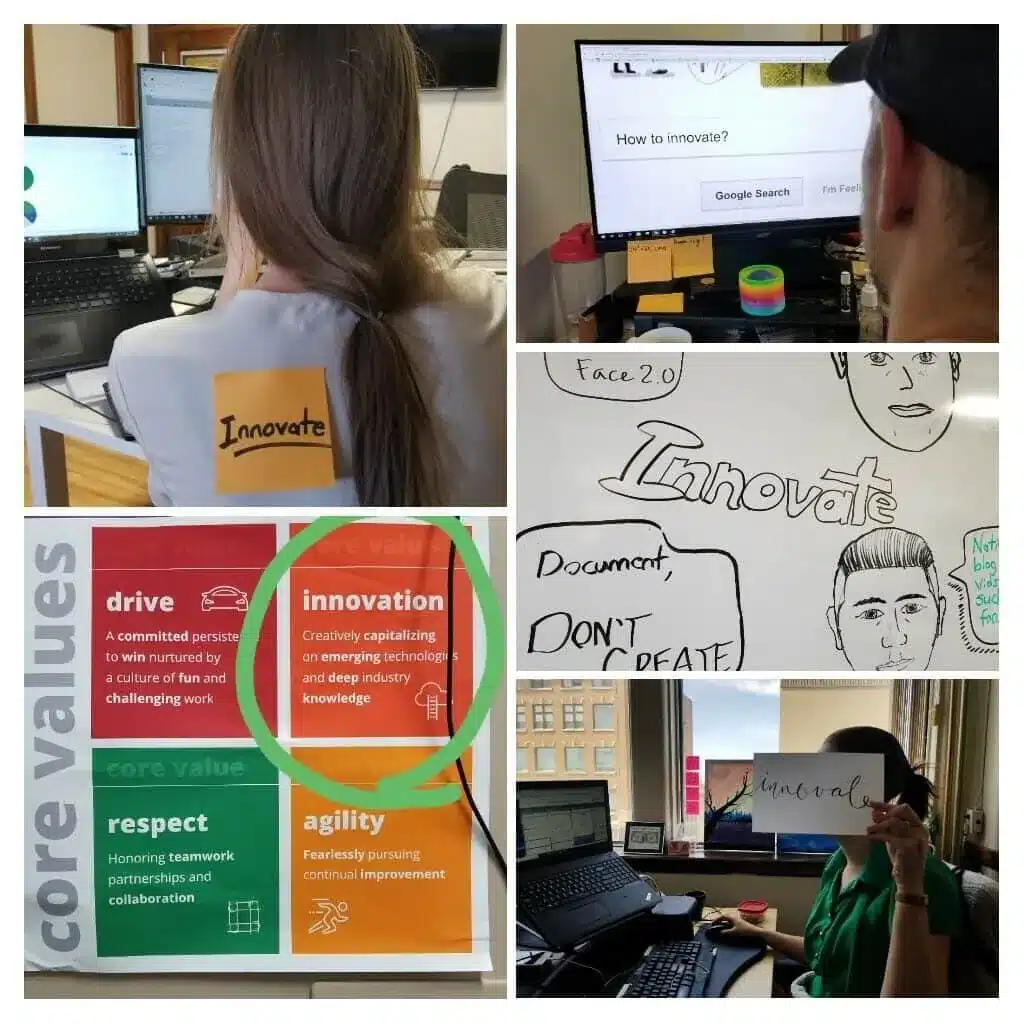
Vendasta’s extensive experience in the realm of digital marketing and content generation translates into a premier ability to generate native advertising content. We pride ourselves on being the #1 resource for local. When implemented with the rest of Vendasta’s local marketing stack, we can create a very robust offering for our partners.
After years of extensive experience generating digital content for marketing agencies, we have developed a highly skilled team of digital marketers. As a result of popular demand, and a growing interest in native ad tactics, Vendasta has further grown the diversification of our product offering to include a native ad service.
This means that if you are a marketing agency, our sophisticated team of content specialists are just itching to take your native ad writing requests off your hands so that you can easily scale and grow your business. We are the marketing agency for your marketing agency, if you will.
Just to make things a little clearer, let’s revisit our graphic from above and see where Vendasta fits into the equation:
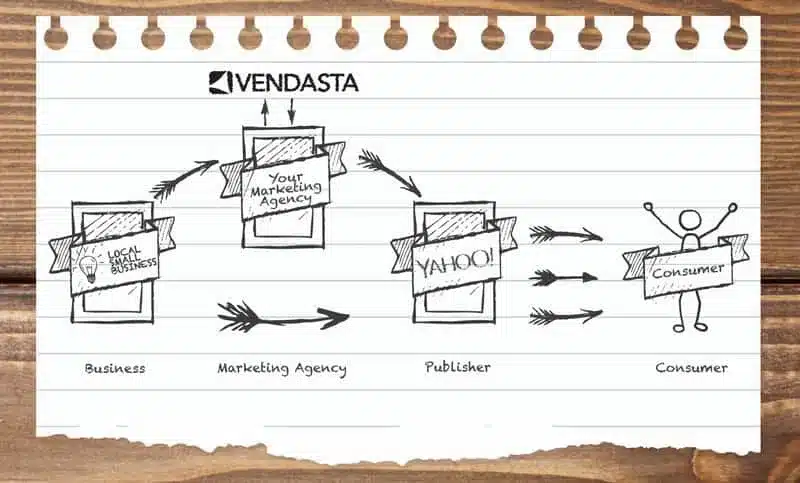
How a Native Advertising Service Adds Value:
- These large publishing companies want to keep their writers doing what they already excel at: news, so they need the help of an agency.
- You want to have a marketing agency that is scalable, we can make that a reality—without the overhead.
- Local businesses don’t want to add another company to their partner portfolio, they want to get all of the services they need in one place. We can ensure that you are the one-stop shop for all of your clientele.
We’ve got a seat for you on our native advertising rocket ship, and we’ll make sure that you never get left behind.
Conclusion:
It’s going to take time and maybe even an industry disruptor, but native is the future of advertising.
Ready to see a demo of Vendasta’s native advertising services? Request a Demo now.
How are you planning to implement native advertising for your business, your agency, or your publishing site?
Let us know in the comments below, we’re excited to see where this native advertising rocket ship will take us all!

